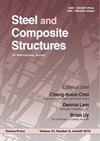Influence of micromechanical models on the bending response of bidirectional FG beams under linear, uniform, exponential and sinusoidal distributed loading
IF 3.9
3区 工程技术
Q1 CONSTRUCTION & BUILDING TECHNOLOGY
引用次数: 2
Abstract
This paper investigates the effect of micromechanical models on the bending behavior of bidirectional functionally graded (BDFG) beams subjected to different mechanical loading. The material properties of the beam are considered to be graded in both axial and thickness directions according to a power law. The beam's behavior is modeled by the mean of quasi 3D displacement field that contain undetermined integral terms and involves a reduced unknown functions. Navier's method is employed to determine and compute the displacements and stress for a simply supported beam. Different homogenization schemes such as Voigt, Reus, and Mori-Tanaka are employed to analyze the response of the BDFG beam subjected to linear, uniform, exponential and sinusoidal distributed loading. The results obtained by the present method are compared with available results in the literature and a good agreement was found. Several numerical results are presented in tabular form and in figures to examine the effects of the material gradation, micromechanical models and types of loading on the bending response of BDFG beams. It can be concluded that the present theory is not only accurate but also simple in predicting the bending response of BDFG beam subjected to different static loads.微力学模型对线性、均匀、指数和正弦分布荷载下双向FG梁弯曲响应的影响
本文研究了微力学模型对双向功能梯度梁在不同力学荷载作用下弯曲性能的影响。梁的材料性质被认为是在轴向和厚度方向上按幂律梯度。采用包含待定积分项和约化未知函数的准三维位移场均值来模拟梁的行为。采用纳维耶方法确定和计算简支梁的位移和应力。采用Voigt、Reus和Mori-Tanaka等不同的均匀化方案分析了BDFG梁在线性、均匀、指数和正弦分布荷载下的响应。将所得结果与文献中已有的结果进行了比较,两者吻合较好。以表格和图表的形式给出了几个数值结果,以检验材料级配、细观力学模型和加载类型对BDFG梁弯曲响应的影响。结果表明,该理论对BDFG梁在不同静荷载作用下的弯曲响应预测不仅准确而且简单。
本文章由计算机程序翻译,如有差异,请以英文原文为准。
求助全文
约1分钟内获得全文
求助全文
来源期刊

Steel and Composite Structures
工程技术-材料科学:复合
CiteScore
8.50
自引率
19.60%
发文量
0
审稿时长
7.5 months
期刊介绍:
Steel & Composite Structures, An International Journal, provides and excellent publication channel which reports the up-to-date research developments in the steel structures and steel-concrete composite structures, and FRP plated structures from the international steel community. The research results reported in this journal address all the aspects of theoretical and experimental research, including Buckling/Stability, Fatigue/Fracture, Fire Performance, Connections, Frames/Bridges, Plates/Shells, Composite Structural Components, Hybrid Structures, Fabrication/Maintenance, Design Codes, Dynamics/Vibrations, Nonferrous Metal Structures, Non-metalic plates, Analytical Methods.
The Journal specially wishes to bridge the gap between the theoretical developments and practical applications for the benefits of both academic researchers and practicing engineers. In this light, contributions from the practicing engineers are especially welcome.
 求助内容:
求助内容: 应助结果提醒方式:
应助结果提醒方式:


